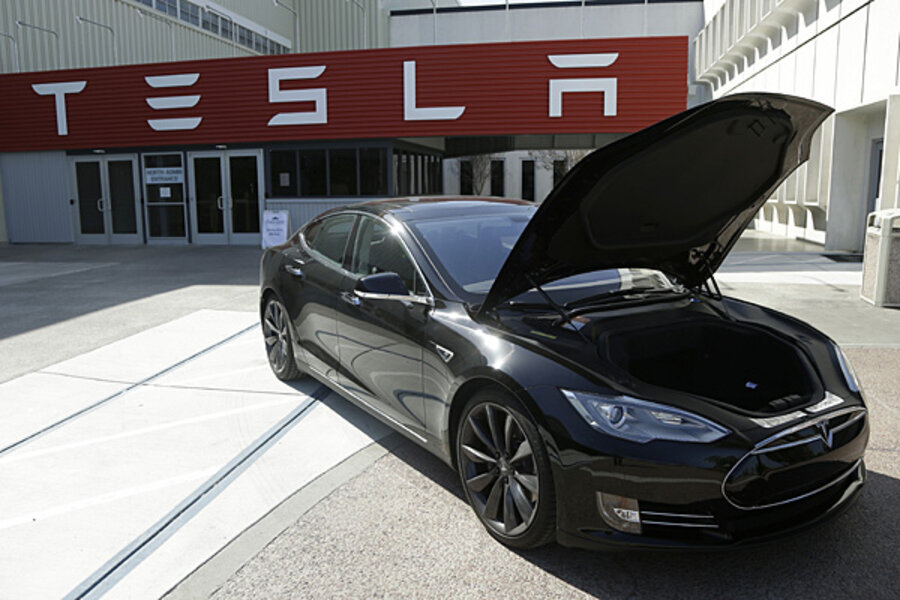Tesla Motors eyes self-driving cars. Are they more efficient?
Loading...
Tesla Motors has made a name for itself rethinking what powers our cars. Now they're taking on who – or rather, what – drives them.
The luxury electric carmaker has joined the race to build a car that drives itself. Autonomous transport promises greater convenience and safety than the human-operated vehicles of today. It also has the potential to dramatically reduce the amount of energy consumed in the transportation – the second most energy-intensive sector behind electric power in the US.
The move puts Tesla in competition with another Silicon Valley giant, Google, which has been working on driverless cars for at least three years.
“With both Google and car companies working in this area, I think it will be doable," Mark Campbell, a professor of mechanical and aerospace engineering at Cornell University who leads a research group on autonomous systems, said in an e-mailed statement. "I would imagine that the starting points are places with longer car commutes and laws that have been tackled, like California, whereas places like New York City will be harder because GPS coverage is more challenging with the tall buildings.”
The engineering of driverless cars is complex – mechanically, legally, and politically. The utopian vision of a seamless, accident-free autonomous transport network won't arrive for a long time, if ever at all. Even Tesla Motors chief executive Elon Musk – no stranger to big, bold ideas – concedes it's difficult.
“My opinion is it’s a bridge too far to go to fully autonomous cars,” Mr Musk said in an interview with the Financial Times. “It’s incredibly hard to get the last few per cent [of miles driven]."
But automating 90 percent of miles driven is possible within three years, Musk said, declining to offer specific details on Tesla's plans.
It's a step towards reducing the inefficiencies of imperfect human pilots. Drivers have a tendency to accelerate too quickly, brake too hard, and jam together in bottlenecks that are as grating on cars as they are on commuters. Driverless cars would optimize traffic with the aid of sensors, data, and algorithms, the theory goes, getting people from point A to B with fewer traffic jams, fewer starts and stops, and thus less energy use.
In 2011 alone, Americans lost 4.8 billion hours, 1.9 billion gallons of fuel, and $101 billion in delay and fuel costs due to traffic congestion, according to the Texas Transportation Institute.
Minimizing drag is another important factor driving the efficiencies of driverless cars. Grouping cars close together in long trains can greatly reduce the amount of wind resistance the cars encounter. That means the engines work less hard and use less gas (or in Tesla's case, electricity), to go the same distance.
But such close proximity is a dangerous proposal if humans are behind the wheel. Despite being warned otherwise, people tinker with the radio or fire off a quick text and otherwise multitask while driving. There's a reason we're taught to keep two car-lengths ahead of us – you never know when someone is going to slam on the brakes.
But a system of autonomous cars networked together could, in theory, move packed tightly together with little safety concerns. This so called "drafting" or "platooning" could reduce highway fuel use by up to 20 percent, according to a University of California, Berkeley study from 1995.
Such a system would also reduce, or even eliminate, the threat of car accidents. That means cars could be built much lighter than they are today, offering room for even more efficiencies. A 20 percent weight reduction corresponds to a 20 percent increase in efficiency, according to an August 2012 report from the Center for Automotive Research, a nonprofit based in Ann Arbor, Mich.
Those are still hypotheticals. And even if a sprawling autonomous transit network were to come about, some suggest it might actually increase the total amount of energy we use to get around by making getting around easier. This so called "rebound effect," is posited in a January post by the Rocky Mountain Institute, an efficiency nonprofit based in Boulder, Colo.
"What if our driverless cars of the future have a valet mode that allows them to park themselves, becoming not just driverless but also passengerless?," the post reads. "What if they run errands for us, such as picking up lunch or dry cleaning or the kids at soccer practice? What if driverless cars—and the efficiencies and flexibility they offer—actually incentivize us to drive more?"
Whatever the answers, those questions get at the futurist, energy-centric issues Musk likes to tackle. Just last month, the Tesla Motors chief unveiled plans for another potential revolution in the transportation/energy sector. The "hyperloop" would connect cities via high-speed, tube-based travel that would offer a cheaper and faster alternative to old-fashioned planes, trains, and automobiles.






